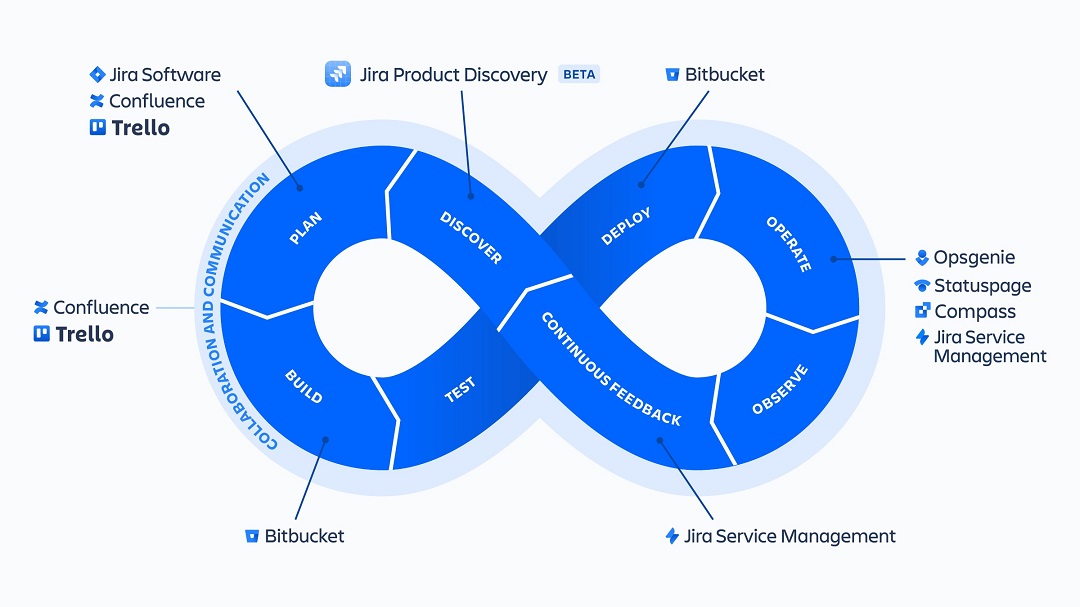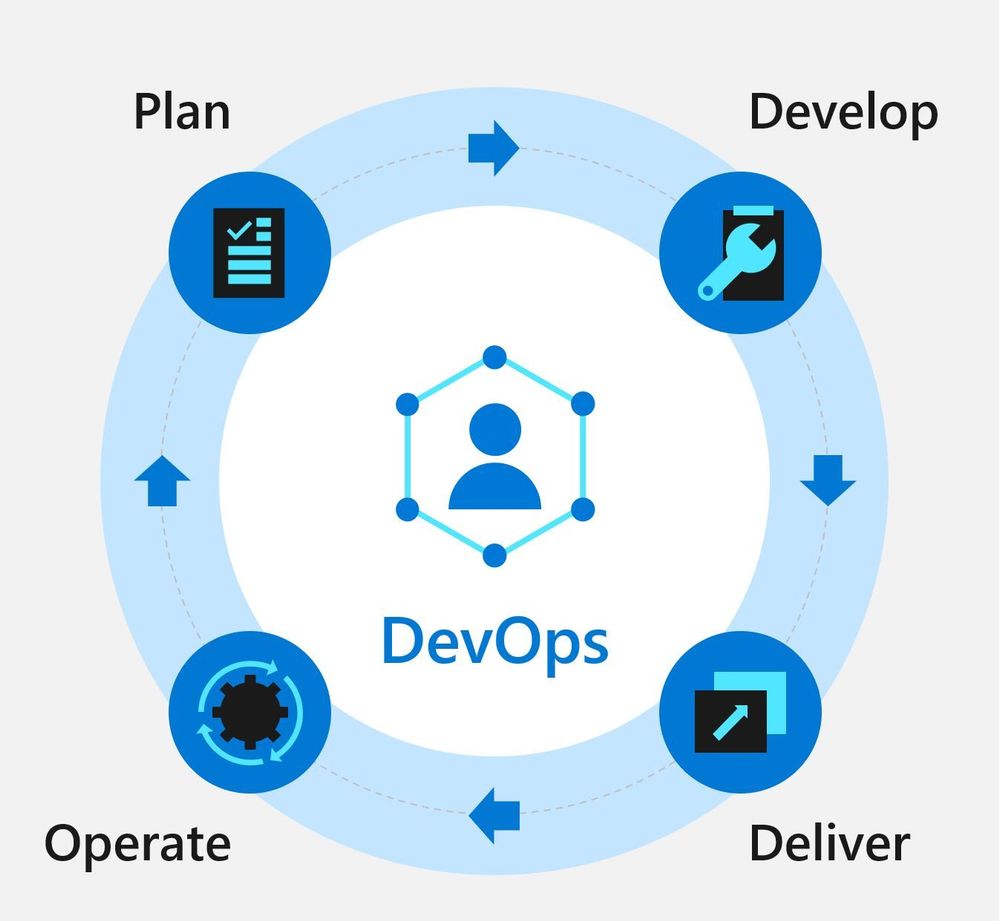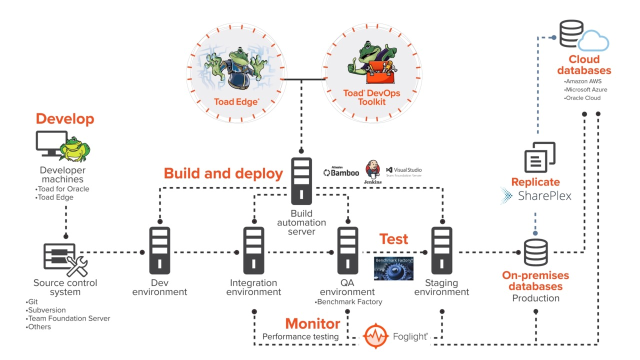The ultimate guide to implementing DevOps in your organization
Published

What are the key principles and concepts of DevOps?

Those : techcommunity.microsoft.com
The key principles and concepts of DevOps revolve around fostering collaboration, automation, and continuous improvement between development (Dev) and operations (Ops) teams to improve software delivery and operational efficiency. These principles can be implemented in a company through the following approaches:
Culture: DevOps emphasizes a collaborative culture that promotes shared responsibility, transparency, and trust between development and operations teams. Companies can implement DevOps by fostering a culture of open communication, cross-functional teamwork, and mutual respect to support collaboration and break down silos.
Automation: Automation plays a critical role in DevOps because it allows companies to streamline and optimize their software development and operations processes. By automating tasks such as build, test, deployment and infrastructure provisioning, companies can achieve faster and more reliable software delivery, reduce manual errors and improve efficiency.
Continuous integration and deployment: DevOps promotes continuous integration and deployment practices where software changes are regularly integrated, tested, and deployed to production. Organizations can implement DevOps by adopting tools and practices that support automated testing, continuous integration, and delivery pipelines, enabling faster and more frequent release of software updates.
Measurement and Feedback: DevOps focuses on measuring and monitoring software delivery and operational metrics to gain insights, identify bottlenecks, and drive continuous improvement. Companies can implement DevOps by using monitoring, logging, and analytics tools to collect data on performance, availability, and user experience and use this feedback to make data-driven decisions and optimize processes.
DevOps tools and technologies: A wide range of tools and technologies are available for implementing DevOps, such as: Examples include version control systems, build and deployment automation tools, configuration management tools, containerization platforms, monitoring and logging tools, and collaboration platforms. Companies can select and implement the right tools tailored to their specific needs and workflows.
Training and education: DevOps requires skilled employees with expertise in both development and operations. Companies can implement DevOps by offering training and education programs for their teams to acquire the necessary skills and knowledge of DevOps practices, tools, and technologies, and promote a culture of continuous learning and improvement.
What are the most common challenges and obstacles when implementing DevOps?

Those : quest.com
Implementing DevOps in an organization can be challenging due to various factors. The most common challenges and obstacles when implementing DevOps include:
Cultural Resistance: It can be challenging to change the culture and mindset of teams accustomed to traditional, silo-like approaches. Overcoming this challenge requires strong leadership support, effective communication, and fostering a culture of collaboration, trust, and continuous improvement. Supporting cross-functional teams, promoting transparency, and recognizing and rewarding DevOps practices and behaviors can help overcome cultural resistance.
Lack of qualified talent: Finding and retaining qualified talent with both development and operational expertise can be challenging. Companies can meet this challenge by offering training and development programs to close skills gaps, fostering a culture of continuous learning, and attracting and retaining talent through competitive compensation, career opportunities, and a supportive work environment.
Legacy systems and processes: Companies with legacy systems and processes may face challenges integrating them into modern DevOps practices. This can be solved by gradually modernizing legacy systems, leveraging tools and technologies that support integration of legacy systems, and employing strategies such as feature flagging and phased rollouts to minimize disruption during the transition.
Complexity of tools and technologies: The DevOps landscape is vast, and there are numerous tools and technologies available that can be overwhelming. Companies should carefully select and implement the right tools that meet their specific needs and workflows, and provide appropriate training and support to ensure the successful adoption and use of these tools.
Lack of automation: Automation is a key aspect of DevOps and the lack of proper automation can hinder the implementation of DevOps practices. Companies should prioritize their automation efforts, identify and automate repetitive and error-prone tasks, and leverage tools for build, test, deployment, monitoring, and other automation needs.
Resistance to change: Change can face resistance from employees who are familiar with existing processes and practices. Companies should invest in change management, clearly communicate the benefits of DevOps, and involve employees in the decision-making process. Providing support, addressing concerns, and demonstrating the positive impact of DevOps can help overcome resistance to change.
Lack of metrics and feedback: Monitoring and measuring DevOps practices and results is critical for continuous improvement. Companies should establish meaningful metrics, set up monitoring and logging tools, and collect feedback to identify areas for improvement and make data-driven decisions.
How DevOps can benefit your business: Understanding the benefits and measuring their impact.

Those : stock.adobe.com
Implementing DevOps in an organization can bring numerous benefits, including:
Faster Software Delivery: DevOps practices such as continuous integration and delivery, automation and collaboration enable faster and more frequent software releases, reducing time to market and improving the company's ability to respond to market demands and customer needs.
Improved software quality: DevOps emphasizes automated testing, code reviews, and continuous monitoring, resulting in higher software quality with fewer errors and vulnerabilities. This leads to higher customer satisfaction, reduced downtime and better overall software performance.
Improved Collaboration and Communication: DevOps promotes a culture of collaboration and cross-functional teamwork that promotes better communication and cooperation between development, operations, and other stakeholders. This leads to better coordination, faster problem solving and better decision making.
Increased operational efficiency: DevOps practices such as automation, infrastructure as code, and streamlined workflows optimize operations and reduce manual errors, resulting in greater operational efficiency, less downtime, and better resource utilization.
Greater innovation and agility: DevOps enables companies to iterate, experiment and innovate quickly, resulting in faster innovation cycles, improved agility and the ability to respond to market changes and customer feedback in a timely manner.
Improved security and compliance: DevOps includes security practices such as automated security testing, vulnerability scanning, and code reviews that help organizations identify and remediate security issues early in the software development cycle, resulting in improved security posture and compliance with industry standards and regulations.
The benefits of DevOps can be measured using various metrics and key performance indicators (KPIs), such as: B:
Deployment Frequency: The number of implementations or releases within a certain period of time, indicating the frequency of software releases.
Change lead time: The time it takes from the initiation of a change to its deployment to production indicates the speed of software delivery.
Mean Time to Recovery (MTTR): The average time required to recover from a fault or incident, indicating the efficiency of the incident resolution and recovery processes.
Defect escape rate: The percentage of defects or problems identified after software release, indicating the effectiveness of testing and quality assurance practices.
Deployment Success Rate: The percentage of successful implementations, indicating the stability and reliability of software releases.
Customer Satisfaction: Measuring customer feedback, ratings and reviews to determine the level of satisfaction with the software and its delivery process.
What are the essential tools, technologies and practices of DevOps?

Those : stock.adobe.com
DevOps involves the use of various tools, technologies, and practices to automate and streamline software development and operations processes, enable collaboration, and promote continuous integration and delivery. Here are some essential tools, technologies, and practices used in DevOps and how they can be effectively integrated into an organization's software development and operations processes:
Version Control Systems (VCS): VCS, such as Other tools, such as Git, are used to manage source code and enable collaboration between team members. Teams can create branches, merge changes, and track revisions, enabling a smooth and controlled process of code development and integration.
Continuous Integration (CI) and Continuous Delivery (CD) tools: CI/CD tools like Jenkins, Travis CI, and GitLab CI/CD automate the process of building, testing, and deploying code changes. These tools ensure that code changes are continually integrated, tested, and deployed to production, reducing the risk of integration issues and enabling fast, reliable software releases.
Configuration management tools: Configuration management tools such as Ansible, Chef, and Puppet automate the deployment and management of infrastructure and ensure that required configurations are consistent across environments, reducing manual errors and enabling infrastructure as code.
Containerization and orchestration tools: Containerization tools such as Docker and container orchestration platforms such as Kubernetes enable the deployment of applications in the form of containers, making them portable and scalable across different environments. These tools enable consistent deployment and management of applications, simplify the deployment process, and improve scalability and reliability.
Automated Testing Tools: Automated testing tools such as Selenium, JUnit, and pytest enable automation of testing processes, including unit testing, integration testing, and end-to-end testing. These tools help identify and fix problems early in the development process, ensuring that the software meets quality standards and reducing the risk of production problems.
Monitoring and logging tools: Monitoring and logging tools such as Prometheus, ELK Stack (Elasticsearch, Logstash, and Kibana), and New Relic provide insights into application and infrastructure performance and health. These tools enable proactive monitoring, troubleshooting and problem solving, ensuring high availability and reliability of the software.
What are the best practices for managing a DevOps environment?

Those : stock.adobe.com
Managing change, automation, and continuous improvement are important aspects of a successful DevOps environment. Below are some best practices for each of these areas and how they can be aligned with a company's business goals and objectives:
Change management:
Establish clear change management processes: Define and document clear processes for managing changes in software development and operations workflows. This includes defining roles and responsibilities, creating change request forms, and setting up approval flows.
Implement version control: Use a version control system to manage changes to code, infrastructure, and configurations. This enables traceability, collaboration and rollback options in the event of problems.
Communicate Changes Effectively: Communicate changes and their impacts to relevant stakeholders, including development teams, operations teams, and other stakeholders. This ensures that everyone involved is aware of the changes and can plan accordingly.
Conduct impact assessments: Conduct impact assessments to identify potential risks and impacts of changes to the existing environment and systems. Reduce risks through appropriate planning and testing.
Monitoring and measuring changes: Monitor and measure the success of changes, including impact on performance, stability and customer satisfaction. Use these metrics to continually improve the change management process.
Automation:
Identify repetitive and error-prone tasks: Identify tasks that can be automated, such as: B. building, testing and deploying code, provisioning infrastructure and configuring environments.
Selecting appropriate automation tools: Select the right automation tools based on the needs and requirements of the business. Consider factors such as ease of use, scalability, and integration with existing tools and technologies.
Plan and prioritize automation initiatives: Develop a roadmap for automation initiatives and prioritize based on the potential impact on productivity, quality, and efficiency. Align automation initiatives with company business goals.
Test and validate automation: Thoroughly test and validate automated processes and workflows to ensure they are accurate, reliable, and secure. Regularly review and update automated processes to adapt to changing business needs.
Continuous improvement:
Establish a culture of continuous improvement: Foster a culture where continuous improvement is encouraged and employees are empowered to identify and correct problems and inefficiencies.
Encourage feedback and learning: Encourage feedback from team members, stakeholders, and customers to identify opportunities for improvement. Promote willingness to learn and provide opportunities for skills development and training.








